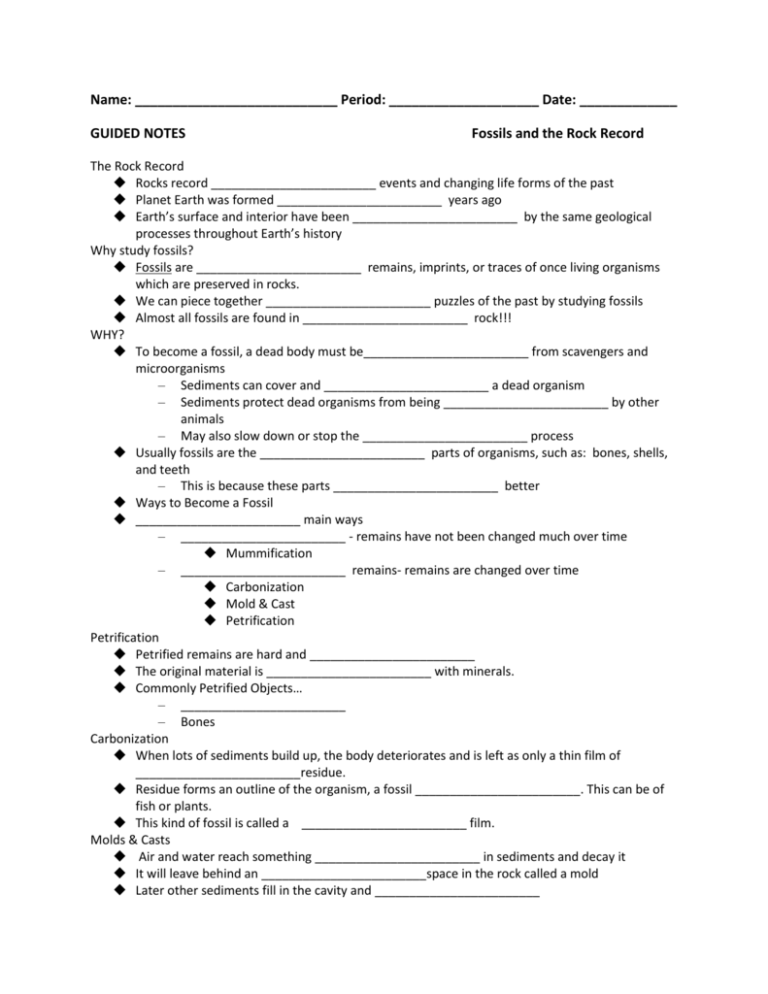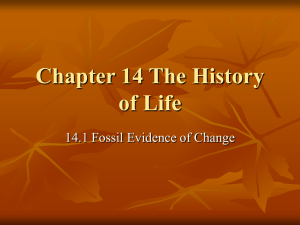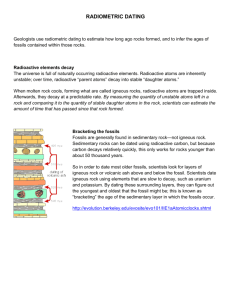Name: Period: Date: ______ GUIDED NOTES Fossils and the Rock
advertisement

Name: ___________________________ Period: ____________________ Date: _____________ GUIDED NOTES Fossils and the Rock Record The Rock Record Rocks record ________________________ events and changing life forms of the past Planet Earth was formed ________________________ years ago Earth’s surface and interior have been ________________________ by the same geological processes throughout Earth’s history Why study fossils? Fossils are ________________________ remains, imprints, or traces of once living organisms which are preserved in rocks. We can piece together ________________________ puzzles of the past by studying fossils Almost all fossils are found in ________________________ rock!!! WHY? To become a fossil, a dead body must be________________________ from scavengers and microorganisms – Sediments can cover and ________________________ a dead organism – Sediments protect dead organisms from being ________________________ by other animals – May also slow down or stop the ________________________ process Usually fossils are the ________________________ parts of organisms, such as: bones, shells, and teeth – This is because these parts ________________________ better Ways to Become a Fossil ________________________ main ways – ________________________ - remains have not been changed much over time Mummification – ________________________ remains- remains are changed over time Carbonization Mold & Cast Petrification Petrification Petrified remains are hard and ________________________ The original material is ________________________ with minerals. Commonly Petrified Objects… – ________________________ – Bones Carbonization When lots of sediments build up, the body deteriorates and is left as only a thin film of ________________________residue. Residue forms an outline of the organism, a fossil ________________________. This can be of fish or plants. This kind of fossil is called a ________________________ film. Molds & Casts Air and water reach something ________________________ in sediments and decay it It will leave behind an ________________________space in the rock called a mold Later other sediments fill in the cavity and ________________________ This produces a ________________________ of the original object ________________________ Remains Sometimes actual remains may be found ________________________ in some way – Amber- Hardened tree sap – Frozen ________________________ – Ice – Tar pits – Mummification Drying Often found in ________________________ caves or buried beneath the desert sand Most ________________________ cannot survive without water, no waterorganism does not decay! Other Fossil Evidence Trace fossils – evidence of ________________________ activity – Tracks – Burrows Tell us about the ________________________ of the animals. Index Fossils From species that were on Earth for a ________________________ amount of time but were abundant Fossils used to determine ________________________ of rock layers Fossils can also be used to determine ________________________ environmental conditions If a scientist found the same index fossil in two different areas of the world this indicates the ________________________ were made at the same time Relative Dating Used to determine ________________________of events and the relative age of rocks by their position in a sequence. Doesn’t tell you the ________________________age Tells you age in ________________________to other rocks ________________________in the rock record are called unconformities. Telling the ________________________age of rock beds Law of Superposition- In an undisturbed layer of rock, the ________________________ rocks are on the bottom and the rocks become progressively younger toward the top. Principle of original horizontality-layers of sediment are generally ________________________ in a horizontal position Principle of cross cutting relationships- states that if a rock layer cuts through another the layer that cuts through must be ________________________ than the layer it cuts Unconformities-________________________ in the rock record Angular Unconformity –Horizontal layers are tilted and lifted ________________________ Disconformity -A ________________________ in the record caused by rocks being exposed and eroded. How it works? Sediment was deposited then eroded and new sediment was ________________________ on top leaving a gap in the record. Nonconformity –sedimentary rock forms above another rock type (igneous or metamorphic). The other rocks are ________________________ and eroded. Absolute Dating Method used by geologists to determine ________________________, in years, of a rock or other object. Uses the ________________________in rocks and other objects. Radioactive Decay Radioactivity-________________________decay of the nuclei of unstable atoms When the number of neurons in an atom change, it becomes a new ________________________ ________________________Life Time it takes for ________________________the atoms in the isotope to decay Ex: Carbon-14 has a half-life of ________________________ – Every 5730 half of the C-14 will decay into N-14 When C-14 decays into N-14, C-14 is considered to be the parent material and N-14 is the daughter product C-14 can be used to date objects up to 70,000 years By measuring the amounts of parent & daughter material, ________________________ can calculate the age of a rock. This is called ________________________dating Radiocarbon Dating Carbon 14 can be used to date fossils, bones, and wood as old as ________________________Organisms take carbon to build tissues and once they die, it decays away Used mostly for igneous and metamorphic rocks…can not be used for sedimentary rocks Uniformitarianism Principle that states that the ________________________ occurring today are similar to the processes from the past. Used this theory to argue ________________________ those who thought the Earth had only been around for a few thousand years.







